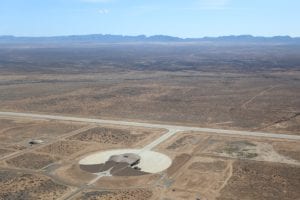Inside Spaceport America
In the Jornada del Muerto desert basin, Spaceport America seems to emerge from the ground as if about to take off – almost as if the Enterprise or the Millennium Falcon were emerging from the desert terrain to look out on its 12,000 foot by 200 foot “spaceway,” with the vast desert encircling the spaceport’s campus. Spaceport America is positioned between Albuquerque and El Paso, about 25 miles from Truth or Consequences, New Mexico.
 “We call ourselves the first purpose-built commercial spaceport in the world in that we were made specifically to be a commercial spaceport: we weren’t repurposed from a military facility, or a NASA facility, or something like that,” explained Spaceport America’s outgoing CEO, Christine Anderson. “It was pretty wide-open as to what one should look like and how to operate one.” Christine retired from the Air Force after 30 years of civilian experience, and soon became CEO of Spaceport America during its construction in 2011. “I’ve always said I’m so happy I had those years in the Air Force, because it’s so hard to prepare for a job like this,” she smiled. Christine spent over 10 years of her Air Force experience working on space systems, and had experience operating out of military spaceports when she was contacted about the position at Spaceport America. “I thought about it, and I thought it was going to be a lot of work but it was going to be really fascinating what the commercial space industry was going to do with all of this cool technology,” she said. “I thought I’d do it for a year, and it’s been five and a half years now. But I’m glad I had my background in the Air Force because I’ve used almost every bit of what I learned, plus some on this job, because it’s a very broad job.”
“We call ourselves the first purpose-built commercial spaceport in the world in that we were made specifically to be a commercial spaceport: we weren’t repurposed from a military facility, or a NASA facility, or something like that,” explained Spaceport America’s outgoing CEO, Christine Anderson. “It was pretty wide-open as to what one should look like and how to operate one.” Christine retired from the Air Force after 30 years of civilian experience, and soon became CEO of Spaceport America during its construction in 2011. “I’ve always said I’m so happy I had those years in the Air Force, because it’s so hard to prepare for a job like this,” she smiled. Christine spent over 10 years of her Air Force experience working on space systems, and had experience operating out of military spaceports when she was contacted about the position at Spaceport America. “I thought about it, and I thought it was going to be a lot of work but it was going to be really fascinating what the commercial space industry was going to do with all of this cool technology,” she said. “I thought I’d do it for a year, and it’s been five and a half years now. But I’m glad I had my background in the Air Force because I’ve used almost every bit of what I learned, plus some on this job, because it’s a very broad job.”
One of 10 FAA-licensed spaceports in the United States, Spaceport America is unique because it was built from scratch instead of adapted from an existing airport. “We had the luxury of doing that, and I think we set the bar fairly high as to what these should look like,” Christine smiled. “They should be exciting places, they should be inspirational places, and I think it’s pretty exciting looking. It looks like the future.” Beauty and function meet at Spaceport America: the terminal hangar facility leased by Virgin Galactic has won architectural awards, and the building is certified LEED Gold. “[The LEED certification] is hard to do in any event, and for such a complex building it was equally challenging,” Christine admitted. “We had to bring all the materials in from quite a distance and even had to put the road in to get to the spaceport to bring the materials to the Spaceport. It’s basically a small city.” The spaceport is self-contained with its own wells, wastewater systems, electricity, and even EMT and fire services. “None of it was there. It was beautiful, high-desert country in Southern New Mexico,” Christine explained.
“When I first got this job over five years ago I called a few airports and asked ‘What does your business model look like? How do you sustain yourself?’ Invariably, they said we get money from airplane travel, of course, but we also have a broader business base,” Christine explained. Airports may receive income from parking, rental car services, and concessions, and Christine took that advice to heart. “We are in an emerging industry. It isn’t a real stable and predictable business base yet,” she said. “A lot of these companies are in their test stages and sometimes they have their setbacks.”
 These setbacks Christine referenced have led some to call Spaceport America ahead of its time: ready for its tenants before its tenants are ready to fly into space. Today, the spaceport has expanded its book of business to include different launches, more tourism and events, and it has even been a filming location for a new movie, The Space Between Us, set to release in December 2016. “Because it is such a beautiful space, we thought tourism – or terrestrial tourism, as we like to call it – is one avenue for revenue, but there’s also others such as the film industry, photoshoots for cars and motorcycles, weddings, and corporate events,” she noted. Spaceport America hosts an open house twice a year, in April and October, allowing private pilots to fly in and the local public to drive in.
These setbacks Christine referenced have led some to call Spaceport America ahead of its time: ready for its tenants before its tenants are ready to fly into space. Today, the spaceport has expanded its book of business to include different launches, more tourism and events, and it has even been a filming location for a new movie, The Space Between Us, set to release in December 2016. “Because it is such a beautiful space, we thought tourism – or terrestrial tourism, as we like to call it – is one avenue for revenue, but there’s also others such as the film industry, photoshoots for cars and motorcycles, weddings, and corporate events,” she noted. Spaceport America hosts an open house twice a year, in April and October, allowing private pilots to fly in and the local public to drive in.
The spaceport continues to diversify its offerings with its tenants, who use the facility for unmanned aerial vehicle (UAV, or drone) testing, satellite ground stations, and more. The Spaceport can support vertical suborbital launches, as well as horizontal launches – like those used by Virgin Galactic, and those used by other airplanes. “We can support aviation types of companies that want to do aerospace testing – not necessarily the ‘space’ part but the ‘aero,'” Christine explained.
The anchor of the spaceport, Virgin Galactic signed a 20-year lease with the facility, and Virgin founder Richard Branson rappelled from the roof of the terminal (accompanied by his children and ballet dancers) in a jaw-dropping stunt at the facility’s dedication as “The Gateway to Space,” showering the building with Champagne. Up Aerospace operates missions under NASA’s Flight Opportunities program, and has flown over a dozen missions from the spaceport. Exos Aerospace Systems & Technologies, Inc., is another tenant, a company interested in the cargo transportation aspect of space travel, and SpaceX also rents property at the spaceport.
Christine is excited to see the future of space travel through Spaceport America. She likened the early days of space travel to those of air travel. “I think now with space travel, eventually it’s going to be just like the train or the airplane in that you don’t have to think about it, you’re going to get in and you’re going to go somewhere.” In addition to opening up the doors of travel, Christine believes that the advancements in space travel will encourage students to look into STEM fields. “This is a real catalyst for the next generation to get excited about science and math … I say if kids are interested in those fields, there’s no reason why they can’t participate in this. It’s going to be so exciting in the future, and it’s going to be wide open where you can go from a career perspective and a transportation perspective.”
Related Stories
Cheers to 20 Years
Six members of Team Jet Linx celebrate two decades of Five-Star service.
READ MORE
Immerse Yourself
More than 40 years after pioneering one of the first health and wellness resorts in Tucson, AZ, Jet Linx Elevated Lifestyle partner Canyon Ranch continues to redefine what wellness-focused getaways can offer.
READ MORE
What Kind of Caviar Are You?
Whether you are a caviar newbie or a seasoned connoisseur, Jet Linx Elevated Lifestyle partner Petrossian has a caviar for your tastes.
READ MORE
Related Stories
Cheers to 20 Years
Six members of Team Jet Linx celebrate two decades of Five-Star service.
READ MORE
Immerse Yourself
More than 40 years after pioneering one of the first health and wellness resorts in Tucson, AZ, Jet Linx Elevated Lifestyle partner Canyon Ranch continues to redefine what wellness-focused getaways can offer.
READ MORE
What Kind of Caviar Are You?
Whether you are a caviar newbie or a seasoned connoisseur, Jet Linx Elevated Lifestyle partner Petrossian has a caviar for your tastes.
READ MORE



Contact Us